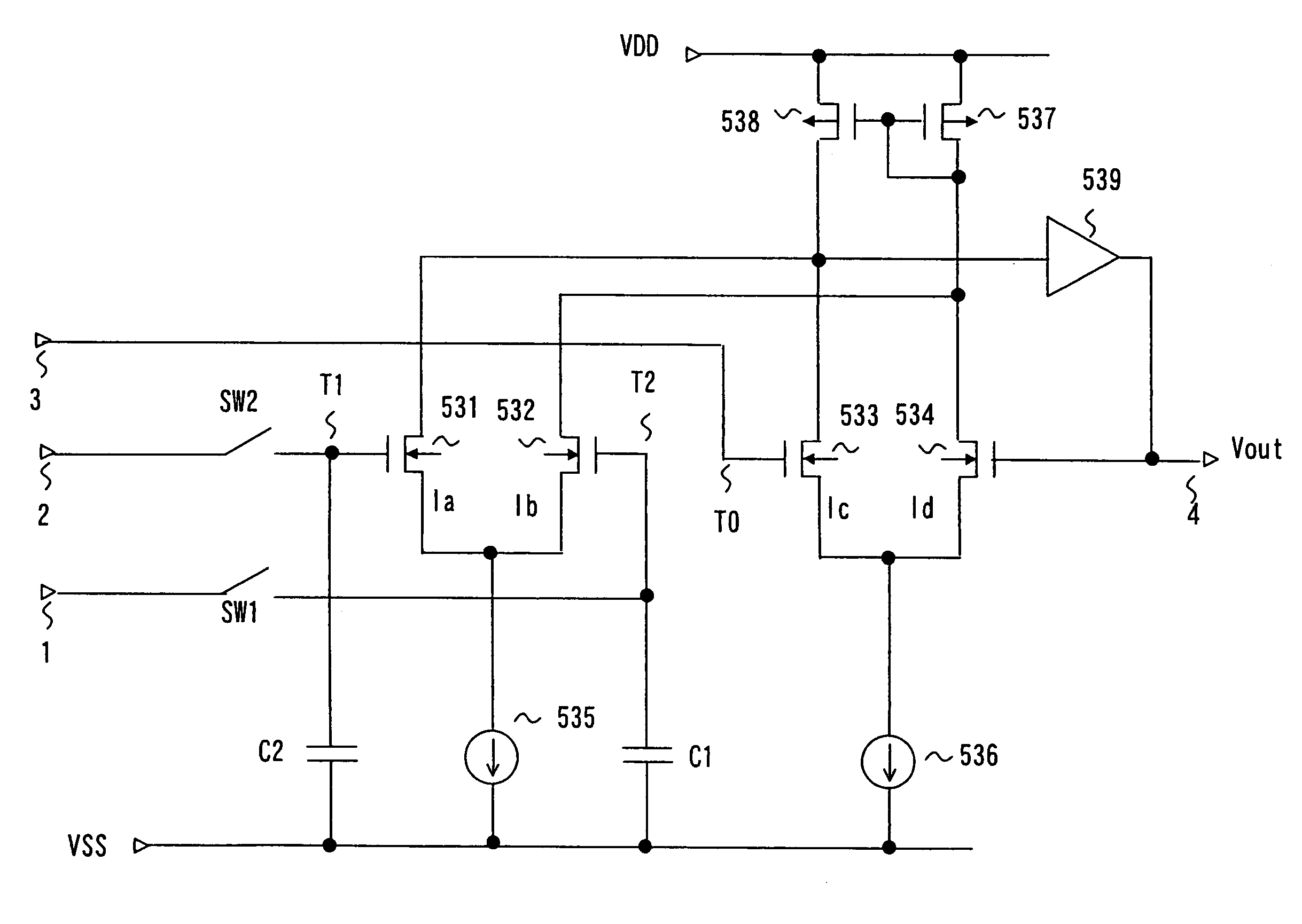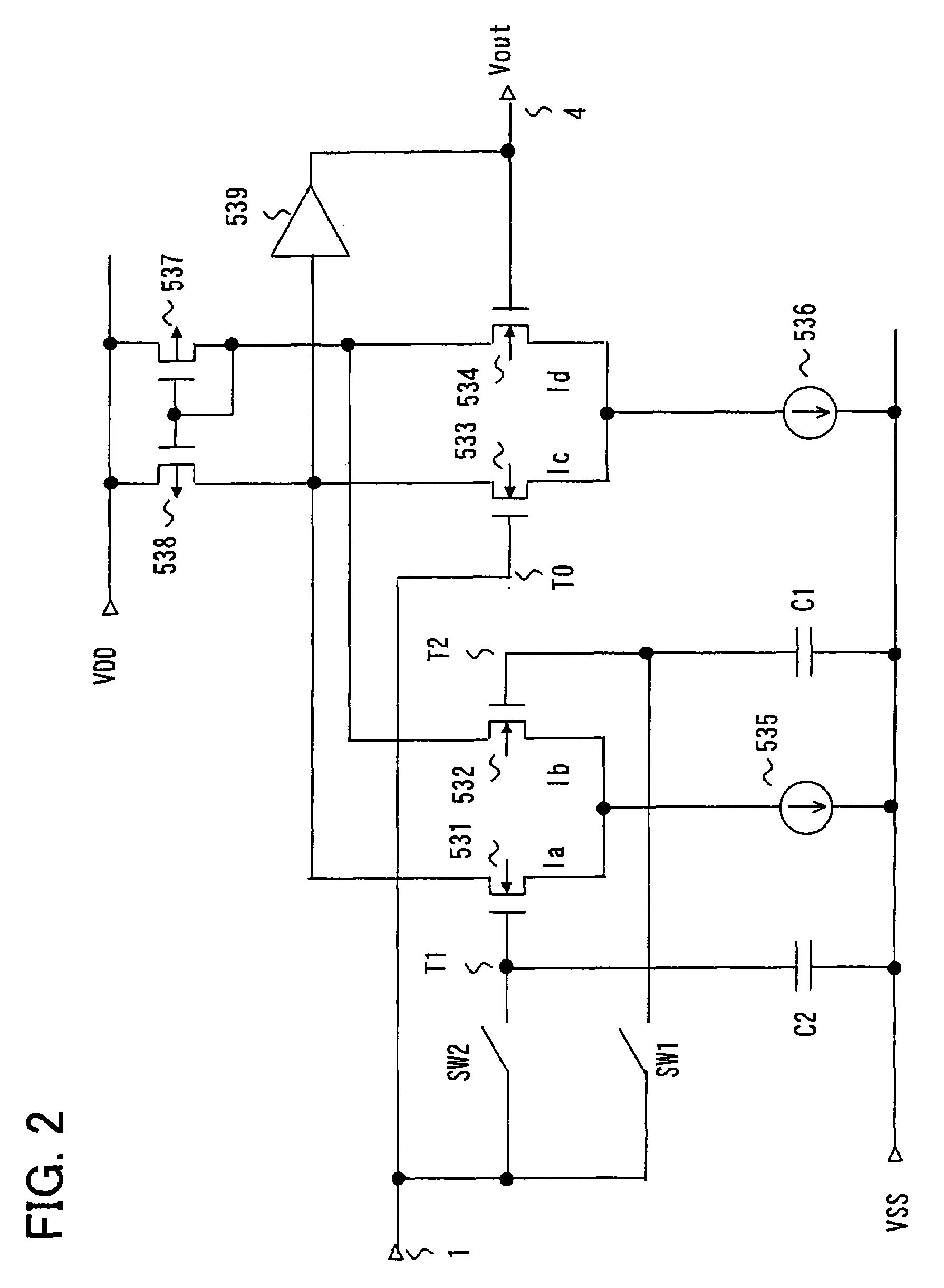Differential amplifier and digital-to-analog converter
a technology of digital to analog converter and differential amplifier, which is applied in the direction of analogue/digital conversion, code conversion, amplifier modification to reduce noise influence, etc., can solve the problem that the configuration cannot meet the demand for high-speed operation, and achieve high-speed operation, suppress the influence of power supply noise, and reduce the input capacitance
- Summary
- Abstract
- Description
- Claims
- Application Information
AI Technical Summary
Benefits of technology
Problems solved by technology
Method used
Image
Examples
example 1
[0062]FIG. 1 is a drawing showing the configuration of a differential amplifier of a first example of the present invention. Referring to FIG. 1, the differential amplifier of this example comprises NMOS transistors 532 and 531 constituting the first differential pair (531 and 532), and having their sources connected in common and their gates respectively connected to the terminals 1 and 2 via switches SW1 and SW2, a constant current source 535 connected between the common source of the NMOS transistors 532 and 531 and the low potential side power supply VSS, NMOS transistors 533 and 534 constituting the second differential pair (533 and 534), and having the sources connected in common and the gates respectively connected to the terminal 3 and the output terminal 4, the constant current source 536 connected between the common source of the NMOS transistors 533 and 534 and the low potential side power supply VSS, a PMOS transistor 537 having the source connected to a high potential s...
example 2
[0084]Next, a second example of the present invention will be described. FIG. 2 is a drawing showing the configuration of the second example of the present invention. Referring to FIG. 2, this example has the same configuration as the differential amplifier shown in FIG. 1 except that the terminals 1, 2, and 3 are made into one common terminal 1. Note that the terminal T0 is directly connected to the terminal 1. One ends of the switches SW1 and SW2 are respectively connected to the input pair (the terminals T2 and T1) of the differential pair (531 and 532), and the other ends are connected in common to the terminal 1. Other than that, the configuration of this example is identical to that of the first example described above.
[0085]In this example, the voltages received by the terminals T0, T1, and T2 are supplied serially from the terminal 1. The switches SW1 and SW2 are switch-controlled from ON to OFF in the order of the voltages supplied to the terminals T2 and T1, and the voltag...
example 3
[0096]Next, a third example of the present invention will be described. FIG. 5 is a drawing showing the configuration of the third example of the present invention. Referring to FIG. 5, this example further comprises a switch SW3 connected between the output terminal 4 and the terminal T2 and a switch SW4 connected between the output terminal 4 and the terminal T1, in addition to the configuration of the differential amplifier shown in FIG. 2. Other than that, the configuration of this example is identical to the configuration shown in FIG. 2. This example differs from the second example described above in how the switches are controlled.
[0097]FIG. 6 is a drawing for explaining the operation of the differential amplifier shown in FIG. 5, and it shows the order in which the voltages V(T0), V(T1), and V(T2), eventually received by the terminals T0, T1, and T2 of the differential pairs, are supplied from the input terminal 1 during a data period and how the switches SW1, SW2, and SW3 a...
PUM
 Login to View More
Login to View More Abstract
Description
Claims
Application Information
 Login to View More
Login to View More - R&D
- Intellectual Property
- Life Sciences
- Materials
- Tech Scout
- Unparalleled Data Quality
- Higher Quality Content
- 60% Fewer Hallucinations
Browse by: Latest US Patents, China's latest patents, Technical Efficacy Thesaurus, Application Domain, Technology Topic, Popular Technical Reports.
© 2025 PatSnap. All rights reserved.Legal|Privacy policy|Modern Slavery Act Transparency Statement|Sitemap|About US| Contact US: help@patsnap.com



